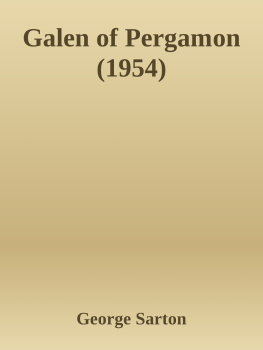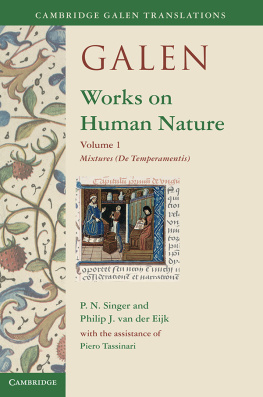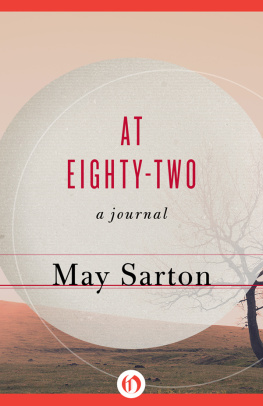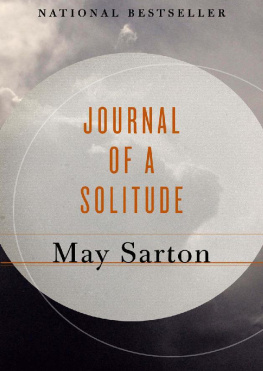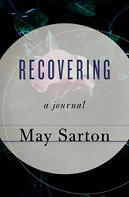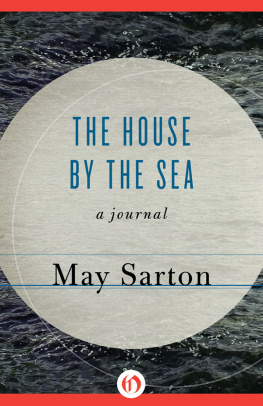George. Sarton - Galen of Pergamon.
Here you can read online George. Sarton - Galen of Pergamon. full text of the book (entire story) in english for free. Download pdf and epub, get meaning, cover and reviews about this ebook. year: 1954, publisher: University of Kansas Press, genre: Science. Description of the work, (preface) as well as reviews are available. Best literature library LitArk.com created for fans of good reading and offers a wide selection of genres:
Romance novel
Science fiction
Adventure
Detective
Science
History
Home and family
Prose
Art
Politics
Computer
Non-fiction
Religion
Business
Children
Humor
Choose a favorite category and find really read worthwhile books. Enjoy immersion in the world of imagination, feel the emotions of the characters or learn something new for yourself, make an fascinating discovery.
- Book:Galen of Pergamon.
- Author:
- Publisher:University of Kansas Press
- Genre:
- Year:1954
- Rating:3 / 5
- Favourites:Add to favourites
- Your mark:
- 60
- 1
- 2
- 3
- 4
- 5
Galen of Pergamon.: summary, description and annotation
We offer to read an annotation, description, summary or preface (depends on what the author of the book "Galen of Pergamon." wrote himself). If you haven't found the necessary information about the book — write in the comments, we will try to find it.
Galen of Pergamon. — read online for free the complete book (whole text) full work
Below is the text of the book, divided by pages. System saving the place of the last page read, allows you to conveniently read the book "Galen of Pergamon." online for free, without having to search again every time where you left off. Put a bookmark, and you can go to the page where you finished reading at any time.
Font size:
Interval:
Bookmark:
Logan Clendening Lectures on the History and
Philosophy of Medicine
Third Series
Galen of Pergamon
by
George Sarton
[ pages reflowed from fuzzy . djvu copy which is sometimes better detailed]
[needs more careful proofing especially the Latin, French and German ]
UNIVERSITY OF KANSAS PRESS, LAWRENCE, KANSAS... 1954
Copyright, 1954, by the University of Kansas Press
All Rights Reserved
Library of Congress Catalogue Card Number:
54-8112
PRINTED IN THE U.S.A.
BY THE UNIVERSITY OF KANSAS PRESS
LAWRENCE, KANSAS
To be invited to deliver the Clendening Lectures in the University of Kansas was a great privilege, and I would like to begin mine with a tribute to the memory of Dr. Logan Clendening. We were born in the same year, I in Ghent, Belgium, and he in Kansas City, but this was my first visit to his native town, and I never had the honor and pleasure of meeting him in the flesh. Yet, I can see him because of his own words which often revealed his generous nature and because of the words of his friends, in particular, Dr. Ralph H. Major.1 His was an astounding personality, and we owe gratitude to him not only for what he did himself but also for the encouragement he gave to others. He was primarily a physician, but he was a physician who loved old books and old learning, and loved them more and more as he grew older. I need not speak of his collections, which are now the main treasure of the University of Kansas Medical Center. He had travelled widely to obtain them and to visit as a pilgrim the main medical shrines; he was a humanist as well as a physician, a teacher of the humanities, and he influenced many students and colleagues in the same way that Welch, Osier, and Cushing influenced them. The medical profession and indeed all the scientific professions need such men deeply. Kansas City and the University of Kansas were very fortunate to have him in their midst, and they have him forever.
--
1. Ralph H. Major: Logan Clendening (Bulletin of the history of medicine 18, 199-206, 1945) with portrait and bibliography.
Galen of Pergamon
As I am writing these lines, the sad news of Dr. Skinner's death reaches me and I would like to evoke his memory also. Though he was primarily a physician and radiologist, under the influence of Dr. Clendening and of Dr. Ralph Major, he became more and more interested in the history of medicine, was appointed a special lecturer in the subject and helped to enrich the Clendening Library. He died in Kansas City on January 11, 1953, at the age of 72 years.2
I delivered two lectures, the first at the University of Kansas in Lawrence, Kansas, May 1, 1952, the second, the following day at the Medical Center in Kansas City, Kansas. The first lecture dealt with the Alexandrian Renaissance, the second with Galen, two subjects separated by an interlude of more than three centuries.
This book reproduces the second lecture as faithfully as possible, but not the first. This requires an explanation, which I am delighted to give, because I feel that there is a great need of it.
My Kansas lectures were spoken lectures, delivered in a living way with a minimum of notes. There is an immense difference between a spoken lecture and a.written paper, and it is a great pity that so few scholars appreciate it and that so many insist on reading aloud learned papers which are meant to be read silently and individually by each reader at his own speed. The difference between a spoken lecture and a written paper is of the same kind as that between a fresco to be seen by a large audience from a distance, and a miniature which should be examined very closely.
--
2. For more information, see Medical Center Bulletin, Kansas City, February 1953.
As the speaker must avoid details which the listener could not catch on the wing, it is possible for him to cover a much wider field. For example, in my first lecture, I gave a survey or panorama of the astounding Renaissance which took place in Alexandria in the third century before Christ. I dealt with an apparently endless series of topics, and my written account of them will cover hundreds of pages of the second volume of my History of science . The second lecture was easier to indite, because it dealt mainly with a single personality,it is true, one of the greatest in the whole history of science. Even so, reading it aloud would take almost three hours. In my opinion, the reading aloud of a written paper is a cardinal sin, as deplorable as meretricious writing; it is a wicked procedure, utterly contemptuous of the audience and unfair to it.
As mechanical progress discourages the printing of Greek type, it has become necessary to transcribe the Greek words in our alphabet as exactly as possible. The diphthongs are written as in Greek, with the same vowels (e.g., at, not ae; ei, not i; oi, not oe), except ou, which is written u to conform with English pronunciation (by the way, the Greek ou is not a real diphthong but a single vowel sound). The omicron is always replaced by an o, and hence Greek names are not Latinized but preserve their Greek look and sound. There is really no reason for giving a Latin ending to a Greek name when one is writing not in Latin but in English. Hence, we write "Epicuros," not "Epicurus" (the two u's of the Latin word represent different Greek vowels). We indicate the differences between the short vowels epsilon and omicron and the long ones eta and omega, as we have just done in their names. Hence, we shall write Heron, Philon, but some names have become so familiar to English readers that we must write them in the English way. We cannot help writing "Plato" instead of "Platon" and "Aristotle" instead of "Aristoteles," etc. For more details, see my History of science , p. xvii. 28
February 1953George Sarton
Preface v
- The Roman World in the Second Century 3
- Pergamon 6
- Galen's Life 15
- Galen's Writings 25
- The Medical Sects in Galen's Time 30
- The Anatomist and Physiologist 39
- The Physician, Surgeon, and Pharmacist 61
- The Philosopher, Historian, and Philologist 70
- Character and Style 78
- Galen's Influence 88
Appendix I. Chronological Summary:
1. Galen 94
2. Roman Emperors 94
3. Galen's Contemporaries Mentioned in the Text 95
Appendix II. Galenic Treatises
Translated from the Arabic 99
Appendix III. Galenic Texts
Available in English Translation 101
Index 109
Illustrations
Map of the Country around Pergamon 7
Plan of the Asclepieion 11
Abbreviations
Indications such as "(HI-2 B.C.)" or "(II-l)" after a name mean two things: (1) the man flourished in the second half of the third century before Christ or in the first half of the second century; (2) he is dealt with in my Introduction.
CMG . Corpus Medicorum Graecorum ediderunt Academiae Berolinensis Havniensis Lipsiensis. Berolini in aedibus Academiae Litterarum , 1927 ff. (Isis 42, 348, also 150).
History of science. Sarton's book of that title, vol. 1, published by the Harvard University Press, 1952. It deals with ancient science down to the end of the fourth century B.C.
Horus. Sarton: A guide to the history of science (xviii +316 p.; Waltham, Mass.: Chronica Botanica, 1952).
Introd. Sarton: Introduction to the history of science (3 vols, in 5; Baltimore: Williams & Wilkins, 1927-48).
Isis . International review devoted to the history of science and civilization (45 vols., 1913-54). Now published by the Harvard University Press, Cambridge, Mass.
Font size:
Interval:
Bookmark:
Similar books «Galen of Pergamon.»
Look at similar books to Galen of Pergamon.. We have selected literature similar in name and meaning in the hope of providing readers with more options to find new, interesting, not yet read works.
Discussion, reviews of the book Galen of Pergamon. and just readers' own opinions. Leave your comments, write what you think about the work, its meaning or the main characters. Specify what exactly you liked and what you didn't like, and why you think so.

